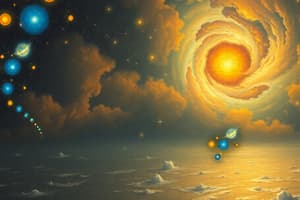Podcast
Questions and Answers
What forms when hydrogen exists at tremendously high pressure and hot temperatures?
What forms when hydrogen exists at tremendously high pressure and hot temperatures?
- Unbreakable building blocks of matter
- Dense plasma of ionized hydrogen nuclei (correct)
- Solid atoms moving through void
- Rearrangement of subunit triangles responsible for transformations
Who developed the theory of atomism and believed that all matter was composed of four elements?
Who developed the theory of atomism and believed that all matter was composed of four elements?
- Ancient Greek and Modern Alchemist (correct)
- Carl Sagan, the author of Cosmos
- Brand, who discovered phosphorus
- Platonic philosophers
What did Brand accidentally discover in 1669 while searching for the 'philosopher's stone'?
What did Brand accidentally discover in 1669 while searching for the 'philosopher's stone'?
- Cosmic plasma
- Phosphorus (correct)
- DNA composition
- Gold
According to Carl Sagan, what are humans made of?
According to Carl Sagan, what are humans made of?
What did the Greek philosopher believe all matter was composed of, besides the solid atoms?
What did the Greek philosopher believe all matter was composed of, besides the solid atoms?
What substances are thought to have their origins in the interiors of stars much later in the history of the Universe?
What substances are thought to have their origins in the interiors of stars much later in the history of the Universe?
When did the universe cool enough to form stable protons and neutrons according to the text?
When did the universe cool enough to form stable protons and neutrons according to the text?
What process is responsible for the formation of all stars according to the text?
What process is responsible for the formation of all stars according to the text?
What event started about one minute after the Big Bang?
What event started about one minute after the Big Bang?
Which event marks the starting point for the universe as we know it, according to the text?
Which event marks the starting point for the universe as we know it, according to the text?
Flashcards are hidden until you start studying
Study Notes
Star Formation and Element Creation
- Hydrogen exists at extremely high pressure and hot temperatures, forming dense plasma of ionized hydrogen nuclei, which leads to self-sustaining nuclear reactions and the star's "ignition".
- Ancient Greek and Modern Alchemists developed the theory of atomism, proposing that the universe is composed of solid atoms constantly moving through empty space.
- The Greek philosopher believed that all matter was composed of four elements: fire, air, water, and earth, and that these elements could be balanced in infinite possibilities.
Atomic Theory and the Universe
- The atomic theory of the universe states that everything in the universe is composed of atoms that are unbreakable building blocks.
- The Greek philosopher also mentioned the existence of geometric solids (Platonic solids) and believed that the rearrangement of subunit triangles is responsible for transformations between different forms of matter.
Discovery of Elements and the Universe
- In 1669, Brand accidentally discovered the chemical element phosphorus while searching for the "philosopher's stone", a substance believed to transmute base metals into gold.
- Carl Sagan stated that the elements in our bodies, such as nitrogen, calcium, iron, and carbon, were made in the interiors of collapsing stars, and that "we are made of star stuff".
Life Cycle of Stars and Element Formation
- The formation of light and heavier elements occurs during star formation and the universe.
- The life cycle of stars includes the formation of light elements (deuterium, helium, and lithium) in the first few minutes of the Big Bang, and elements heavier than helium originate in the interiors of stars.
- All stars are formed by aggregation of interstellar "dust", which is mostly hydrogen.
The Big Bang and the Universe
- The Big Bang theory is the most supported explanation for the origin of the universe, stating that the universe began with a small singularity that inflated over 13.8 billion years.
- The universe as we know it started with the Big Bang, which released all of the matter and energy that is still present today.
- The gravitational force started to draw substances together into bodies that became the first massive stars about one minute after the Big Bang.
Studying That Suits You
Use AI to generate personalized quizzes and flashcards to suit your learning preferences.




